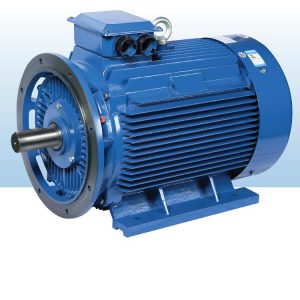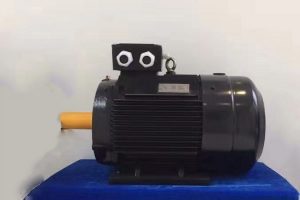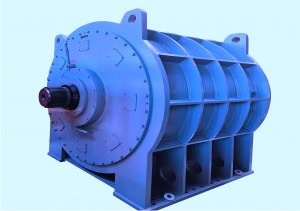In settings where choosing the motor is crucial for operations success. Because of their reliability and efficiency factors, permanent magnet motors and induction motors stand out as popular choices among engineers and businesses alike. It is vital for decision-makers to comprehend the nuances between these motor variants to make informed choices considering factors such as performance capabilities and cost implications. This piece explores the disparities between permanent magnet motors and induction motors, while highlighting ENNENG’s cutting-edge solutions, in magnet motor technology.

Magnet motors utilize magnets to create the field of the rotor. However, induction motors rely on inducing electric currents in the rotor to establish the magnetic field required for operation purposes. Both of them are capable of functioning. They are different in their structure, efficiency levels, and how they operate in various settings.
Power Source: The PMM leverages permanent magnets, eliminating the need for external excitation. However, the induction motors generate their magnetic field through electrical induction in the rotor.
Efficiency: The PMM typically exhibits higher energy efficiency due to lower rotor losses, making them ideal for applications that require consistent energy savings. Induction motors experience more energy loss due to rotor currents, especially under varying loads.
Size and Weight: Permanent magnet motors are generally smaller and lighter than induction motors, providing higher power density. This makes The PMM advantageous in applications where space is limited or weight is a concern.
Torque and Speed Control: The PMM offers superior torque and speed control, particularly at low speeds. Induction motors, while reliable, may experience reduced efficiency when subjected to variable speed conditions.
Maintenance: The PMM has fewer components like slip rings and brushes, leading to lower maintenance requirements. Induction motors, while rugged, often require more frequent upkeep due to the presence of more mechanical parts.
ENNENG permanent magnet motors are recognized for their improved efficiency and performance capabilities. Let’s delve into the advantages they offer;
High Efficiency: The PMM operates without generating heat in the rotor, significantly reducing energy losses. This results in overall higher efficiency, particularly in energy-intensive applications like manufacturing and automation.
Compact Design: Due to their high-power density, the permanent magnet is smaller and lighter than the equivalent of an induction motor. This is particularly beneficial for industries where space is a constraint, such as robotics, automotive, and aerospace sectors.
Reliable Performance: The PMM delivers consistent torque even at low speeds, providing smooth and reliable performance across a variety of industrial applications.
ENNENG is devoted to the research and development of various special high & low voltage Low-speed High-torque permanent magnet motors, constant-speed permanent magnet motors, and special direct-drive permanent magnet motors.
The Permanent Magnet Motor offered by ENNENG is known for its efficiency and power output capabilities, in industrial settings such as pumps and fans due to its strong build and consistent performance across different speeds. Making it a dependable option, for industries valuing efficiency and longevity.
Key Features: High efficiency, wide speed range, low energy consumption.
Applications: Suitable for general-purpose industrial applications like conveyors, pumps, and compressors.

The Direct Drive and Gearless Motor from ENNENG provides a design that leads to lower energy loss and improved efficiency due to the absence of gears. This motor is ideal for tasks in areas, like wind turbines, elevators, and electric vehicles.
Key Features: Gearless operation, high precision, reduced maintenance.
Applications: Wind turbines, electric vehicles, and elevators.
ENNENG General Type Permanent Magnet Motor is crafted for applications, in industries with an uncomplicated yet efficient design that ensures reliable performance and excellent efficiency levels across a wide range of speed and torque requirements, in diverse industrial settings.
Key Features: Versatility, high efficiency, adaptability to different load conditions.
Applications: Widely used in manufacturing processes, HVAC systems, and water treatment plants.
ENNENG provides designed Permanent Magnet Motors tailored to suit the needs of various applications. Their engineering team can create a motor that is specifically designed for processes or customized performance requirements as, per your specifications.

Key Features: Custom design, optimized for specific applications, superior performance.
Applications: Custom industrial machinery, bespoke automation systems, and specialized manufacturing equipment.
Many different types of industries see advantages in utilizing magnet motors for their efficiency and versatility allowing them to outperform induction motors in certain aspects.
The PMM is often the preferred choice in automated manufacturing due to the energy efficiency and precise control over torque and speed. For example, in high-precision applications such as CNC machining and robotics, ENNENG’s Direct Drive and Gearless Motor ensure accuracy without the energy loss associated with induction motors.
In electric vehicles (EVs), The PMM is widely used due to the higher power density and efficiency, contributing to longer battery life and improved vehicle performance. The Tailor Permanent Magnet Motor from ENNENG can be optimized for EVs, ensuring maximum performance while reducing energy consumption.
For renewable energy applications like wind turbines, permanent magnet motors provide the efficiency and reliability needed for continuous operation. ENNENG’s Direct Drive Motor is particularly suitable for these uses, reducing mechanical wear and maintenance compared to traditional induction motor setups.
Induction motors remain common in water treatment plants and HVAC systems due to their rugged design and lower initial cost. However, ENNENG’s General Type Permanent Magnet Motor offers a high-efficiency alternative that reduces energy consumption and operating costs over time.
Induction motors have long been an option, in industries for their durability and affordability; however permanent magnet motors are becoming increasingly popular due to their higher efficiency, compact size, and improved performance capabilities. ENNENG offers a selection of magnet motors ranging from standard models to customized solutions making them a great fit, for businesses seeking to boost energy efficiency cut down operational expenses, and enhance overall system performance.
Whether you work in manufacturing industries or deal with energy production and automotive sectors alike; selecting the motor can have an influence, on your day-to-day operations and financial outcomes. ENNENG’s dedication to pioneering advancements guarantees that their permanent magnet motors meet and even surpass industry norms by delivering performance in a range of applications.